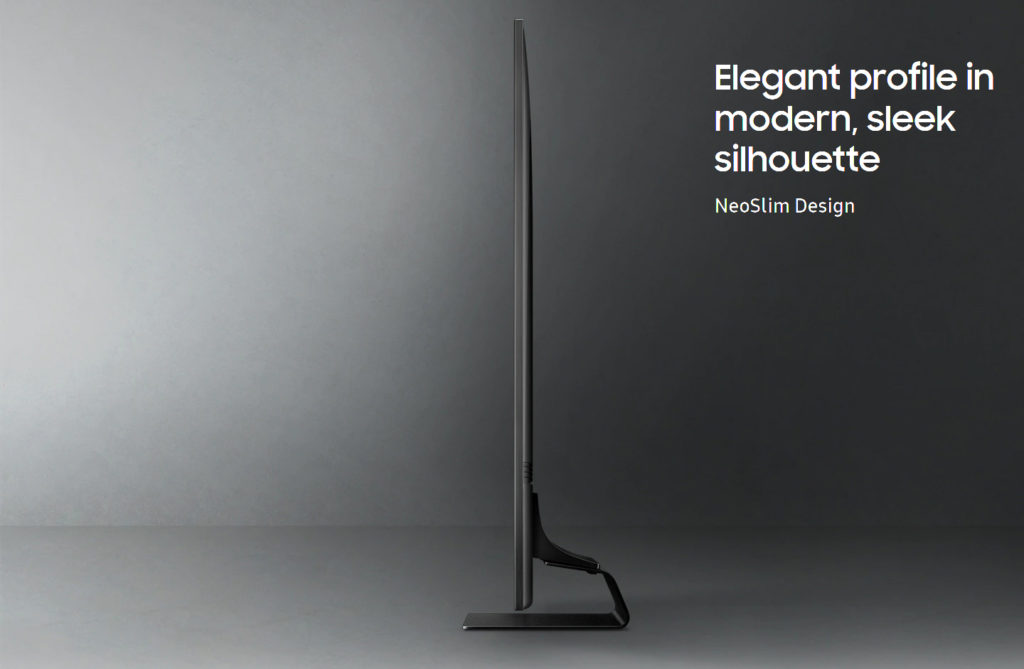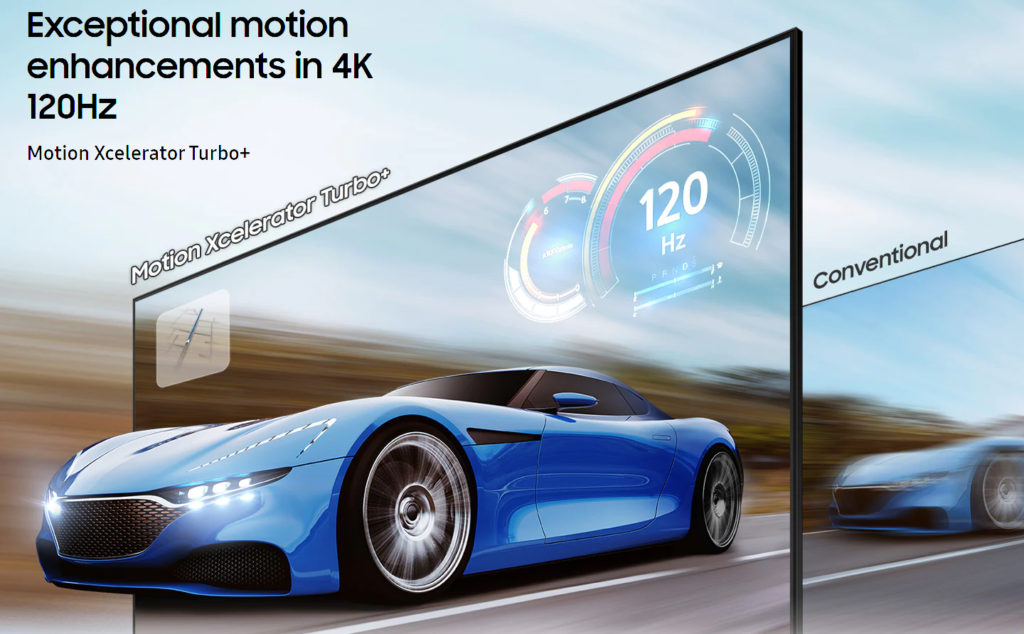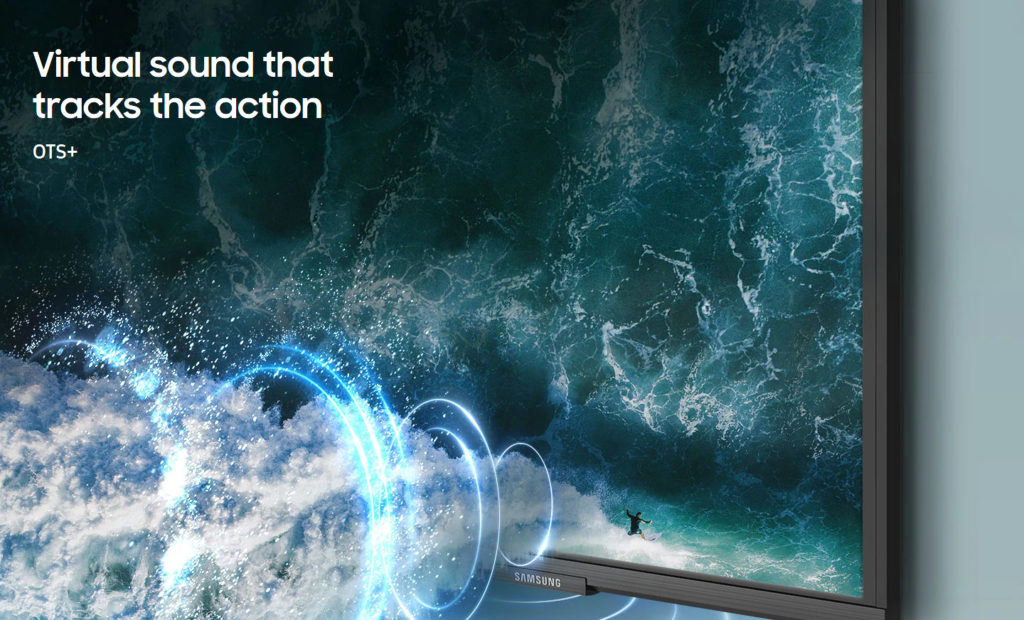If You’re about to spend on a TV, there are very few reasons not to buy an organic light-emitting diode model. Each pixel in an OLED screen acts as its own backlight, and that built-in contrast provides a gorgeous viewing experience.
For years, Samsung – which doesn’t make an OLED TV – has been touting that its high-end backlit LED screens get brighter (and thus work better in brighter rooms) than OLEDs from LG, Sony, and Vizio. This claim fell largely short once you got the two technologies side by side. Brightness be damned, without the near-perfect contrast of OLED, Samsung’s didn’t actually look better. It wasn’t until I got my eyes on the new QN90A that my opinion started to change.
Depending on what and where you watch, the QN90A might actually be a better-looking TV. Samsung’s Mini LED backlighting inches very close to OLED’s perfect contrast, and speedy processing makes it a perfect companion for high-end gaming PCs and consoles. If you watch in brighter rooms or in large groups from varying angles, it’s probably the best-looking TV for you.
Samsung LED- Revolution
Mini LED uses thousands of tiny LEDs to backlight the display, and the technology is now getting very close to OLED-level performance when it comes to blacks, without the limitations imposed by OLED’s Achilles’ heel: brightness.
LED TVs can get brighter than OLEDs, which makes them better for eye-catching colors and bright rooms. Think about moving your cell phone screen from a bright room to a dark one; it needs much more backlighting to look good in sunlight. That’s important, because not everyone has the luxury of a purpose-built home theater. Brightness has a noticeable impact, especially when OLED’s inherent contrast advantage is minimized.
The QN90A looks amazing even with the lights on. When I was watching Formula 1 races and soccer matches, the color of the cars and the green of the field were gorgeous. Even dark shows like The Mandolorian looked great. Turn off the lights and it’s one of the most vivid viewing experiences you’ll find.
But viewing in super-dark rooms is just about the only time you’ll really notice that the TV isn’t getting quite as black as an OLED can. Turn down the lights and put on a film set in space; you’ll notice there’s a touch of “light bloom” around brighter objects, which is when the light from the backlight bleeds around the sides of the illuminated subject.
Sleek Design
From a sheer aesthetic standpoint, there’s nothing to dislike about the Samsung QN90A. It has a beautiful look with premium materials and looks great both wall mounted and on its stand. In terms of design, however, the stand is a bit dicey.
When we had the TV fully set up on the stand, with screws fastened as tight as possible, there was still a reasonable amount of wobble to the TV. It wasn’t as bad as the Sony XR X90J that we lambasted last year for its shakiness, but it’s still much less stable than we’d like. Of course, we can only speak about the 65-inch version of the TV that we had in for testing the 55-inch TV might be totally fine with its lower weight and center of gravity.
One of the reasons the QN90A is a bit more unstable this year is because it’s a bit thinner. Compared to last year, Samsung shaved about half an inch from the depth from the TV which has meant making some compromises on sound quality and stability. That’s not a bad thing if you plan on connecting the TV to an external sound system – like one of Samsung’s Dolby Atmos soundbars – and wall-mounting the TV, but it’s all worth noting.

The other issue with the Samsung QN90A’s design is that it only comes with one full-bandwidth HDMI 2.1 port. That could be a slight problem down the road, but the good news is that, for now, all four ports can handle both the PS5 and Xbox Series X at 4K/120Hz, VRR and ALLM. Despite all four ports working well for the consoles, port 3 is the only port to support eARC, so you’ll want to use that for a soundbar.
Unfortunately, all of these ports are located directly on the back of the TV and not on Samsung’s OneConnect box, which is only available with the QN95A, Q800A and Q900A models. The QN90A does have a way to hide wires by tucking them into the grooves of the back of the TV – but it’s not as elegant of a solution as the OneConnect box is.
What is an elegant solution, however, is the new eco-friendly remote that runs off a solar-powered battery. It works right out of the package, and then re-charges every night by sitting on the edge of the window sill. By the time we wanted to watch TV again in the mid-morning or early afternoon, the remote was fully charged again.
Besides being easy to charge, the remote uses Bluetooth, which means it works without line-of-sight to the TV, and it comes with a built-in microphone that can be used to query smart assistants. Overall, it’s still quite solid despite being one of the smaller mainstream TV remotes and the eco-friendliness of it definitely wins it some points in our book.
The QN90A is well-designed. I prefer the inch-thick, nearly bezel-less panel of Samsung’s Mini LED model to the paper-thin LG C1 OLED I previously reviewed. To be honest, having a TV that thin only seems cool until you try to manipulate it out of the box, onto a wall, or onto the included stand. With the Samsung, I had no fears of crushing the display with my fingers.
I also like the pedestal-style center stand, which makes it fit easily on TV stands from the pre-flatscreen era. It just barely sits above Samsung’s soundbars, so if you have a taller bar, you might want to wall-mount the TV.
With a modern Samsung soundbar like the HW-Q950A in tow, the TV’s built-in speakers can play a supporting role in your listening. It focuses on boosting the center channel—where you’ll find most dialog placed in film and TV mixes—helping them sound like they’re really coming from a character’s mouth. Alone, the TV’s audio is pretty tinny. I strongly recommend grabbing a set of speakers or a soundbar, just like with any other TV.
Samsung’s smart TV interface is clean and functional, with elusive apps like HBO Max available natively. It also works remarkably well as a gaming monitor. The QN90A features Nvidia G-Sync and AMD FreeSync support for variable refresh rates, and can go up to 120 frames per second at 4K resolution. That makes it great if you have any of the latest consoles from Sony and Microsoft, as games will look more fluid and feel more responsive.
I took it for a spin with my AMD Radeon RX 6800 graphics card and *Formula 1 2021—*the short response time and high refresh rate are impeccable. In game mode, it’s nearly as good as the aforementioned LG C1 OLED, which is arguably the best large-format gaming display.
Next-Gen is Now
I didn’t expect to like this mini LED Samsung as much as I did. I always found the beautiful brightness of high-end Samsung models just couldn’t compete with the obscene contrast offered by OLED TVs, even if it worked better in sunlight and at odd angles.

But if the QN90A is proof of anything, it’s that in a few years, OLED-beating performance is sure to come from Samsung’s constant Mini LED innovation. For now, it’s a situational winner.
If you want gorgeous picture quality in a well-lit living room, it’s worth considering. If you almost always watch TV in a dark environment, then stick with an OLED. It runs from 43 inches to 98(!), so you can pick it for everything from a bedroom set to a full-blown home theater.
The Smart TV (Tizen)
Underpinning the Samsung QN90A is the Tizen smart platform that Samsung has been using for, well, what feels like forever. New this year is the ability to change which smart assistant the TV uses and your options include Alexa, Google Assistant and Bixby. We still don’t think Bixby is on par with the other two, but now that’s less of an issue given the fact that it’s easy to switch to one of the others instead.
As for the UI of Tizen, it’s a pretty clean look. Pressing the home button brings up an overlay along the bottom of the screen with your frequently used apps and sources as well as the settings and Ambient Mode. Ambient Mode, more or less, is a lower power mode that helps the TV blend into its surrounding environment while retaining some key information – like the time – up on the screen. It’s been around for a few years now and is still an interior decorator’s dream come true.
The other neat built-in feature for Tizen is Samsung’s proprietary Samsung TV Plus app that blends traditional TV channels with streaming channels for a more robust – and free – app experience. Best of all, Samsung TV Plus looks similar to a lot of cable guides, which means browsing for something to watch is relatively intuitive and you can pick from a number of popular networks like ABC News, MTV, Nickolodeon and more. These channels are all ad-supported, so you’ll see an ad every once in a while, but otherwise it’s a boon for Tizen.
In terms of app support, all the main streaming platforms are there including Netflix, Amazon Prime Video, Disney Plus and Hulu. To download any apps that don’t come built into the TV requires you to sign in using a Samsung account – which is admittedly a bit of a pain – and some apps look better than others. Amazon Prime Video, for example, with its HDR10+ support certainly looks better than HBO Max that, when we tried streaming Mortal Kombat, inexplicably defaulted to the fit-to-screen picture setting and couldn’t be changed. In the end we had to use another streaming device instead, which was a bit of a bummer.
Speaking of UI overlays, it’s also worth talking a bit more about the Game Bar and GameView features of Tizen. While they certainly can be helpful for console gamers as they confirm the refresh rate of the TV, they’re much more helpful for PC gamers. For example, connecting the QN90A to a PC allows you to control the aspect ratio, however you will need to manually adjust the output of the PC for 21:9 (3840×1600 or (2560×1080) or 32:9 (3840×1080). Some gamers will prefer this format while others will be five with 16:9, but having the option does make a strong case for using the Samsung QN90A as a monitor.
To end on a positive note, the TV does support screen casting for most major apps and Apple AirPlay 2. Sharing content to the screen is relatively easy and extremely convenient – plus, if you use a Samsung smartphone or smart watch, you can sync your biometric data to the TV using the built-in Samsung Health app. It’s not worth tossing out your iOS device for if you aren’t already on Samsung’s Android platforms, but it’s a nice perk for those of us who are.
Picture Quality
Of course, a TV of this caliber is all about picture performance and it’s here that the QN90A really delivers the goods. To wit, most content looks truly jaw-dropping on the QN90A – it’s brighter and more colorful than most other 4K TVs, and thanks to the use of Mini LED, it has better black levels and contrast than other LED-LCD TVs.

To understand why that’s the case, however, we have to peel back the layers of the TV and talk about how the Mini LED backlighting system interacts with the QLED technology. The former, as you might know, adds thousands more LEDs to the backlight compared to traditional LED-LCD screens. Those are divided into more zones and those zones can then be better controlled, resulting in better black levels and contrast. When those Mini LED zones are engaged, they can output higher brightness levels than traditional LED arrays and when you combine the higher peak brightness with the additional range of colors provided by the quantum dot filter of QLED, you’ve got better color saturation and more vibrant images.
That said, the capability to produce brighter, more color-saturated images is one thing – but knowing when and where to employ that technology is a whole different matter. That’s where the Neo Quantum Processor 4K takes over. Using 16 neural networks, the Neo Quantum Processor 4K analyzes images on a frame-by-frame basis, upscaling the image if it’s coming from a sub-4K resolution using an image database and boosting contrast and color saturation.
How much color and contrast can be tweaked by any one of the five picture setting modes. Standard tones down colors and brightness for a more natural picture that will look good in most living rooms, while Dynamic mode is a good fit for rooms with an abundance of natural light. Movie mode adds an almost sepia-like tone to the content, while Film Maker mode turns off motion processing completely for a more cinematic experience. All the modes have their pros and cons, but we found each to be enjoyable in their own way.
But speaking of motion processing, it’s worth talking about the new Motion Xcelerator Turbo+ technology that’s used by the Neo Quantum Processor 4K. It’s slightly more judicious in the way it uses judder reduction, but stutter is still an issue because of the way the TV’s native 120Hz refresh rate. Basically, the TV can overprocess some images, giving films a soap opera effect or, worse, making some scenes that have a bit of a natural shaky cam effect look like something from the Blair Witch Project or Cloverfield – it’s non-stop shaking that can really be a turn off.
The good news is that you can actually go in and tweak the judder and stutter individually through Samsung’s picture settings and we highly recommend doing so.
But what does actual content look like? Games like Returnal on PS5 look amazing, with tear-free motion and very little input latency (sub-10ms) while most 4K HDR movies and shows looked exceptionally good, too. It’s a bit of a disappointment that Samsung still refuses to support Dolby Vision content – but its support of HDR10+ means that shows like Jack Ryan on Amazon Prime Video remain stand-out showcases for Samsung TVs.
Would it be better if the Samsung QN90A used self-emissive technology like the purported QLED-OLED we’ve heard so much about? Sure. There is still a small amount of blooming and issues with grey uniformity (most commonly known as the ‘dirty screen’ effect) but there does seem to be some real improvement in these areas year on year.
Samsung QN90A Neo Specification
| Display Specifications | Values |
|---|---|
| Screen Size | 1m 63cm (65″) |
| Resolution | 3,840 x 2,160 |
| Anti Reflection | Yes |

| Video Specifications | Values |
|---|---|
| Picture Engine | Neo Quantum Processor 4K |
| One Billion Color | Yes |
| PQI (Picture Quality Index) | 45000 |
| HDR (High Dynamic Range) | Quantum HDR 32x |
| HDR 10+ | Certified(HDR10+) |
| Contrast | Quantum Matrix Technology |
| HLG (Hybrid Log Gamma) | Yes |
| Color | 100% Color Volume |
| Viewing Angle | Wide Viewing Angle |
| Micro Dimming | Ultimate UHD Dimming |
| Contrast Enhancer | Yes |
| Auto Motion Plus | Yes |
| Film Mode | Yes |
| Natural Mode Support | Yes |

| Audio Specifications | Values |
|---|---|
| Dolby Digital Plus | Yes |
| Dolby 5.1 Decoder | Yes |
| Object Tracking Sound | OTS+ |
| Q-Symphony | Q-Symphony |
| Dialog Enhancement | Yes |
| Sound Output (RMS) | 60W |
| Speaker Type | 4.2.2CH |
| Woofer | Yes |
| Blutooth Audio | Yes |
| Game Feature | Values |
|---|---|
| Auto Game Mode (ALLM) | Yes |
| Dynamic Black EQ | Yes |
| Super Ultra Wide Game View | Yes |
| Freesync | FreeSync Premium Pro |
| Game Motion Plus | Yes |
| Surround Sound | Yes |
| Game Bar | Yes |
| Connectivity Features | Values |
|---|---|
| HDMI | 4 |
| USB | 2 |
| Composite In (AV) | 1 |
| Digital Audio Out (Optical) | 1 |
| HDMI A / Return Ch. Support | Yes |
| HDMI Quick Switch | Yes |
| Bluetooth | Yes (BT5.2) |
| Ethernet (LAN) | Yes |
| RF In (Terrestrial / Cable input) | 1/0/0 |
| eARC | Yes |
| Wireless LAN Built-in | Yes (WiFi5) |
| Anynet+ (HDMI-CEC) | Yes |
Additional Features
| Adaptive Picture Yes | Active Voice Amplifier Yes |
| Adaptive Sound Adaptive Sound+ | AI Upscale Yes |
| Ambience Ambience Mode+ | Brightness/Color Detection Brightness/Color Detection |
| Accessibility – Voice Guide UK English | Accessibility – Learn TV Remote / Learn Menu Screen UK English |
| Accessibility – Others Enlgarge / High Contrast / Multi-output Audio / SeeColors / Color Inversion / Grayscale / Sign Language Zoom / Slow Button Repeat | Digital Clean View Yes |
| Auto Channel Search Yes | Auto Power Off Yes |
| Caption (Subtitle) Yes | Connect Share™ (HDD) Yes |
| ConnectShare™ Yes (USB 2.0) | EPG Yes |
| Extended PVR Yes | Wireless Dex Yes |
| Cloud Service Microsoft 365 | Filmmaker Mode (FMM) Yes |
| OSD Language Local Languages | BT HID Built-in Yes |
| USB HID Support Yes | Teletext (TTX) Yes |
| Time Shift Yes | IPv6 Support Yes |
| MBR Support Yes | Eco Sensor Yes |
| Weight | Values |
|---|---|
| Package Weight | 39.4 kg |
| Set Weight with Stand | 31.4 kg |
| Set Weight without Stand | 24.4 kg |
| Accessory | Values |
|---|---|
| Remote Controller Model | TM2180E |
| Batteries (for Remote Control) | N/A |
| Optional Stand Support (Y20 Studio) | Yes |
| Mini Wall Mount Support | Yes |
| Vesa Wall Mount Support | Yes |
| User Manual | Yes |
| E-Manual | Yes |
| Power Cable | Yes |
| Slim Gender Cable | Yes |
| Warranty | Values |
|---|---|
| OEM Warranty | 1-Year Standard Manufacturing Warranty |
| Extended Warranty | Buy up to 4-years additional warranty |
| Damage Protection | Buy 1-Year damage protection |
Conclusion
As one of Samsung’s first Neo QLED TVs, the Samsung QN90A is thinner, brighter and bolder than before, offering a high peak brightness and fantastic contrast. Its thinner body comes with a few caveats in the form of thinner sound and a higher center of gravity, and it only sports one full spec HDMI 2.1 port. Its fantastic picture quality makes it an appealing choice, but some minor issues prevent it from being one of the best TVs this year.
Last but not least, there’s the new GameView and Game Bar features. Game Bar shows you all the key specs gamers care about like the current frames per second (FPS) rate and what version of VRR is currently enabled. GameView allows you to transform the screen ratio from 16:9 to 21:9 or even the outlandishly wide 32:9 ratio if you want an ultra-wide monitor experience from your 65-inch TV. It’s honestly a fun idea and can help offset the cost if you use the TV as both your monitor and your living room entertainment screen.

